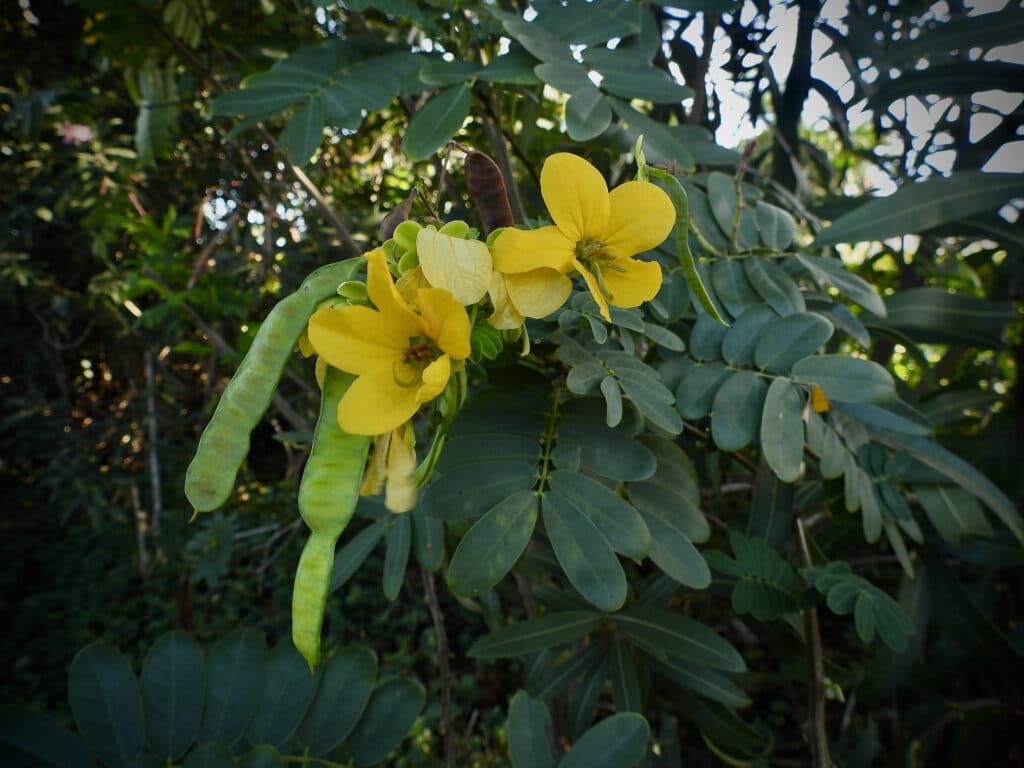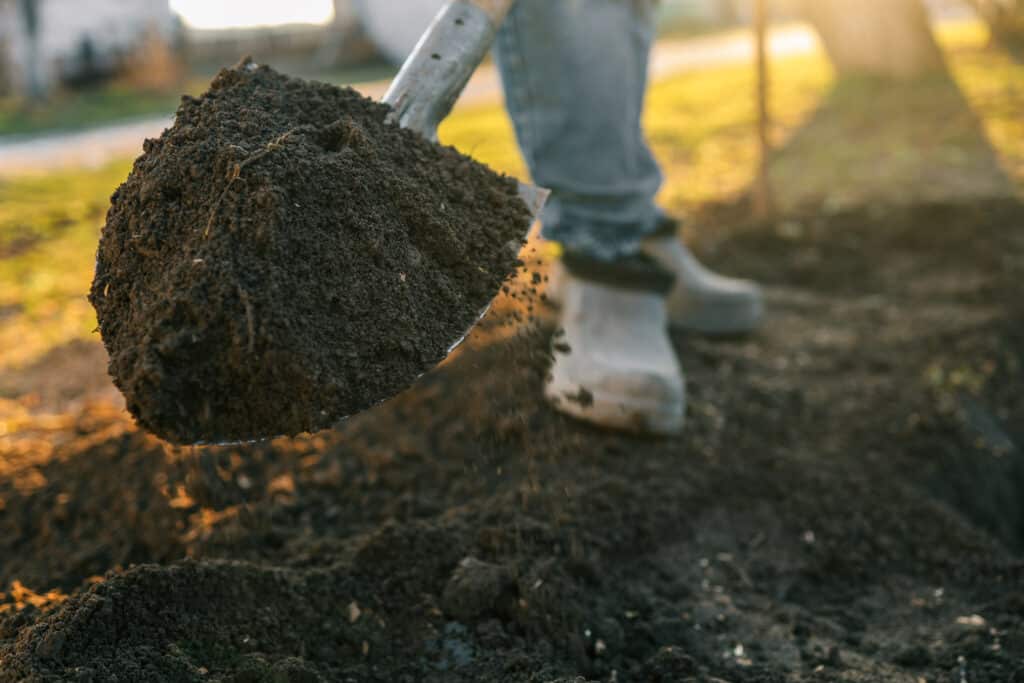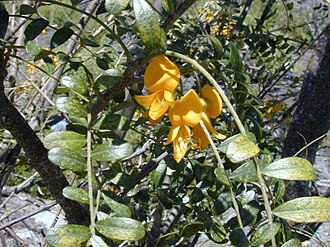Meet the remarkable Māmane (Sophora chrysophylla), a native Hawaiian treasure that’s as tough as it is beautiful. Thriving from the sun-drenched lowlands to the cool, misty highlands, this versatile tree or shrub showcases its resilience in a variety of forms. From the Montane Māmane, which clings to mountainous terrains, to the Lowland Māmane flourishing in warmer valleys, and the Dry Forest Māmane, each adapted to the unique challenges of their habitats. Admire its shimmering, silvery-green leaves and vibrant yellow blooms—a true spectacle of nature’s adaptability in Hawaii’s diverse ecosystems.
Māmane Details
Māmane (Sophora chrysophylla) is a hardy tree or shrub native to Hawaii, capable of growing up to 50 feet tall in optimal conditions. Its pinnate leaves, composed of small leaflets, have a soft texture and a silvery-green hue that stands out in the landscape.
The tree produces vibrant yellow flowers in clusters, which later form seed pods that are vital for feeding native birds like the Palila. During Hawaii’s dry season, the plant conserves water and shows slower growth, while in wetter months, it produces more flowers and seeds.

Varieties and Cultivars
Māmane (Sophora chrysophylla) is a highly adaptable plant with regional variations that allow it to thrive in diverse habitats across Hawaii. While it isn’t formally divided into cultivars, these natural adaptations demonstrate the incredible diversity within this species. Some key varieties and their traits include:
- Montane Māmane: This variety is found in higher elevations, typically ranging from 5,000 to over 9,000 feet above sea level. It grows more compact and dense, making it well-suited for colder and windier conditions. The flowers of Montane Māmane are slightly smaller, and the tree tends to grow slower due to the harsher environment.
- Lowland Māmane: Found at lower elevations, typically around 2,000 to 4,000 feet, this variety grows taller and fuller compared to its high-elevation counterpart. It thrives in slightly warmer temperatures and richer soils, making it an ideal candidate for areas with moderate rainfall.
- Dry Forest Māmane: Native to Hawaii’s arid and rocky regions, this variety has evolved to be extremely drought-tolerant. Its leaves are often smaller and thicker, helping the plant conserve water during long dry periods.
Each of these natural variations contributes to Māmane’s ability to survive and support biodiversity in Hawaii’s challenging and unique environments. Understanding these differences can help when choosing the right Māmane type for native landscaping, ecological restoration, or high-elevation reforestation efforts.
Best Time to Plant
Māmane (Sophora chrysophylla) is a hardy and adaptable plant that can be planted year-round in Hawaii’s tropical climate. However, understanding the island’s distinct wet and dry seasons is essential for choosing the best time to plant and ensuring the long-term success of the tree.
Year-Round Planting Feasibility
Hawaii’s mild climate makes it possible to plant Māmane at any time of the year, as there is no frost or extreme cold to worry about.
That said, young plants are much easier to establish when planted during the wet season, which typically runs from November to April. During this time, regular rainfall ensures that newly planted trees receive adequate moisture to develop strong root systems.
Ideal Planting Seasons in Hawaii
The wet season is the ideal time for planting Māmane, as the consistent rainfall naturally provides the water that seedlings need to establish themselves.
Planting between November and April allows the trees to grow stronger before facing the dry season. If planting during the dry season is unavoidable, additional measures should be taken, such as:
- Watering the seedlings regularly, especially during their first year of growth.
- Applying a layer of mulch around the base of the plant to retain soil moisture and reduce evaporation.
- Selecting planting sites with some shade to protect young trees from intense sunlight.
Timing your planting to coincide with seasonal rain patterns reduces stress on young Māmane plants, promotes quicker establishment, and makes maintenance easier in the long run. This approach is particularly important for restoration projects, where water resources may be limited, and for areas prone to dry, windy conditions.
Growing Conditions
Sophora chrysophylla is a resilient and versatile plant that thrives in Hawaii’s diverse landscapes, from dry lowlands to high-elevation forests. Understanding the ideal growing conditions for this native tree is essential for ensuring its successful establishment and long-term health.
Ideal Soil Types and pH Levels
Sophora chrysophylla prefers well-draining soils, making it particularly suited for Hawaii’s rocky, volcanic terrains. It grows well in both nutrient-poor soils and richer, loamy soils, demonstrating its adaptability.
A slightly acidic to neutral pH range (around 6.0–7.5) is ideal for its growth, though the plant can tolerate more alkaline conditions in dry, arid areas. Amending the soil with organic matter can improve water retention and provide nutrients, especially in degraded landscapes.
Light Requirements
Sophora chrysophylla thrives in full sunlight, making it an excellent choice for open landscapes and areas with minimal shade. The plant can also tolerate partial shade, but maximum sunlight exposure encourages stronger growth, more abundant flowering, and better seed production.
Its ability to handle intense sunlight and dry conditions makes Sophora chrysophylla a perfect candidate for reforestation projects in Hawaii’s sunny, high-elevation regions.
Temperature and Humidity Preferences
As a native Hawaiian species, Sophora chrysophylla is naturally adapted to Hawaii’s warm temperatures and varying humidity levels. It performs well in mild climates at elevations ranging from 2,000 to over 9,000 feet, where temperatures are generally cooler.
Despite its preference for moderate humidity, the plant can also handle arid conditions, particularly in dry montane forests. Its tolerance for temperature fluctuations makes it highly adaptable across the islands’ diverse ecosystems.
Drought and Elevation Adaptability
One of the standout features of Sophora chrysophylla is its incredible drought tolerance. This native tree has evolved to survive in dry, rocky regions with minimal water, making it ideal for areas with limited rainfall.
At higher elevations, where rainfall is often sporadic, Sophora chrysophylla can establish deep roots to access underground moisture.
Planting Instructions
Planting Sophora chrysophylla requires careful preparation and planning to ensure the tree establishes successfully and thrives in its environment. Whether planting for ecological restoration, native landscaping, or home gardening, following these guidelines will help maximize its growth and survival.
Step-by-Step Guide
- Choose the Right Location: Select a sunny site with well-draining soil. Avoid areas prone to waterlogging, as this can harm the roots of Sophora chrysophylla.
- Prepare the Soil: Loosen the soil to a depth of 12–18 inches and remove any weeds or debris. If the soil is poor, amend it with organic matter like compost to improve its structure.
- Planting the Tree: Dig a hole twice as wide and as deep as the root ball. Place the tree in the hole so the top of the root ball is level with the soil surface, then backfill gently.
- Watering: Water the plant thoroughly after planting to help settle the soil around the roots. Keep the soil moist but not soggy during the first few months to support root establishment.
- Mulching: Apply a 2–3 inch layer of mulch around the base of the tree, keeping it a few inches away from the trunk. This helps retain soil moisture and suppress weeds.
Tips for Successful Establishment
- Water Regularly: In the first year, provide consistent watering, especially during the dry season, to help the roots grow deep and strong.
- Protect Young Trees: Use a tree guard or fencing to protect young Sophora chrysophylla from grazing animals or mechanical damage.
- Avoid Overcrowding: Plant trees at least 10–15 feet apart to allow adequate space for growth and prevent competition for sunlight and nutrients.
Importance of Site Selection in Native Restoration Projects
When using Sophora chrysophylla for restoration efforts, selecting the right site is critical for success. The tree thrives in Hawaii’s montane dry and mesic forests, making it ideal for degraded areas within these ecosystems.
Choose sites that mimic its natural habitat, including rocky soils and elevations ranging from 2,000 to 9,000 feet. Proper site selection not only ensures the tree’s survival but also helps restore the ecological balance by supporting native species like the Palila and other forest birds.

Care and Maintenance
Caring for Sophora chrysophylla is relatively easy once it is established, as this native plant is highly resilient and well-suited to Hawaii’s diverse environments.
However, during its early growth stages, proper care is crucial to ensure its long-term health and survival. Regular maintenance will not only encourage faster growth but also keep the tree healthy and thriving.
Watering Needs
Young Sophora chrysophylla plants require regular watering, especially during the dry season. In their first year, water them deeply once or twice a week to help the roots establish.
Once mature, the tree becomes highly drought-tolerant and typically requires minimal supplemental watering. In wetter regions, avoid overwatering to prevent root rot. Using mulch around the base of the tree helps retain moisture and reduces the frequency of watering.
Fertilization Recommendations
Although Sophora chrysophylla can thrive in nutrient-poor soils, occasional fertilization can boost its growth, particularly during its early years. Use a balanced, slow-release fertilizer formulated for native plants, applying it in small amounts once or twice a year.
For more sustainable care, consider adding organic matter like compost to enrich the soil naturally. Avoid excessive fertilization, as the tree is adapted to grow in low-nutrient environments.
Pruning Guidelines
Pruning is an important part of maintaining the health and shape of Sophora chrysophylla. Remove dead, damaged, or diseased branches regularly to improve airflow and reduce the risk of pests or diseases.
Light pruning can also be used to shape the tree or encourage denser foliage. For restoration or landscaping projects, keep pruning minimal to allow the tree to grow naturally and fulfill its ecological role. Always use clean, sharp pruning tools to minimize damage to the plant.
Common Problems and Solutions
Even though Sophora chrysophylla is a hardy and adaptable plant, it can still face a few challenges. Being proactive and understanding potential issues is key to maintaining the health of the plant, especially in restoration or landscaping projects.
Here are some common problems and effective solutions to ensure your Sophora chrysophylla remains strong and healthy.
Common Pests
Sophora chrysophylla is relatively pest-resistant but may occasionally encounter issues with certain insects:
- Aphids: These tiny sap-sucking insects can weaken the plant, causing leaves to yellow or curl.
- Scale Insects: These pests attach themselves to stems or leaves, feeding on sap and leaving behind sticky residue.
- Spider Mites: Common during dry conditions, spider mites can cause leaf discoloration, stippling, and fine webbing.
To manage these pests, wash the leaves with a strong stream of water or apply insecticidal soap. You can also introduce natural predators like ladybugs or lacewings to control infestations.
Common Diseases
Like all plants, Sophora chrysophylla may be affected by diseases, particularly if grown in less-than-ideal conditions:
- Root Rot: Caused by overwatering or poor soil drainage, this disease leads to yellowing leaves, wilting, and stunted growth.
- Fungal Infections: Common in overly damp conditions, fungi can attack the branches or leaves, causing discoloration, spots, or dieback.
To prevent these diseases, ensure the plant is growing in well-draining soil and avoid excessive watering. Prune affected branches to reduce fungal spread and apply fungicides if necessary.
Preventative Measures and Treatments
Proper care is essential to ensure Sophora chrysophylla remains healthy and resilient against common problems. Water deeply but infrequently to encourage strong root growth and prevent waterlogging, as this plant thrives best in well-draining soils.
Mulching can help retain moisture and suppress weeds, but it’s important to keep mulch a few inches away from the trunk to avoid fungal growth. Regularly monitor the plant for early signs of pests or diseases, addressing any issues quickly to prevent long-term damage.
Uses and Landscaping Tips
Sophora chrysophylla is not only an ecological treasure but also a versatile plant that can enhance native gardens, restoration projects, and Hawaiian landscapes. Its bright yellow flowers and silvery-green leaves make it a striking ornamental tree, perfect for adding a touch of natural beauty to high-elevation or dry landscapes.
This plant thrives in areas with poor soil or rocky terrain, making it ideal for reforestation projects aimed at stabilizing degraded land and restoring native habitats. Sophora chrysophylla also serves as a critical companion plant, providing shade and enriching soil quality for other native species in Hawaiian gardens.
Propagation Methods
Propagating Sophora chrysophylla is a rewarding process that allows gardeners and restoration enthusiasts to grow this incredible native plant from seeds or cuttings.
While it is known for its slow growth, the effort is well worth it as this hardy species plays a vital role in Hawaii’s ecosystem.
Propagation from Seeds
Growing Sophora chrysophylla from seeds is the most common method, but it requires patience and proper preparation. The seeds have a hard outer shell, which makes scarification essential for speeding up germination.
To scarify, gently sand or nick the seed coat and then soak the seeds in warm water for 24–48 hours. Once the seeds swell, plant them in well-draining soil and keep them moist until they sprout, which may take several weeks to months.
Propagation from Cuttings
Though less common, Sophora chrysophylla can also be propagated from cuttings. Take semi-hardwood cuttings from a healthy, mature plant during its active growing season.
Dip the cuttings in rooting hormone and plant them in a sandy, well-draining potting mix. Keep the cuttings in a warm, humid environment with indirect sunlight until they develop roots, which may take several weeks.
Environmental Impact and Benefits
Sophora chrysophylla is more than just a beautiful tree; it plays a critical role in maintaining the balance of Hawaii’s ecosystems. As a native species, it supports a wide range of ecological functions and contributes to the preservation of Hawaii’s unique biodiversity.
Planting and caring for this resilient tree not only enhances the environment but also aids in combating many challenges faced by native ecosystems.
Ecological Benefits
Sophora chrysophylla provides essential food for Hawaii’s endangered Palila bird, whose diet depends heavily on the seeds of this plant. Its yellow flowers also attract pollinators like bees and other insects, helping sustain the overall health of the ecosystem.
The deep root system of Sophora chrysophylla stabilizes soil, preventing erosion and improving soil quality in degraded or rocky landscapes. By planting this species, you can help restore native habitats, combat the spread of invasive species, and create sustainable ecosystems.
Potential Drawbacks
While Sophora chrysophylla offers numerous benefits, it does have some challenges that should be considered. The plant has a relatively slow growth rate, especially during its early stages, which requires patience when using it for restoration projects or landscaping.
It can also face competition from invasive species, which may outcompete young Māmane trees for resources like sunlight, water, and nutrients.
Conclusion
Sophora chrysophylla, or Māmane, is a remarkable native plant that embodies the beauty, resilience, and ecological significance of Hawaii’s unique ecosystems.
From supporting endangered species like the Palila bird to restoring degraded landscapes, this tree plays a vital role in preserving the islands’ natural balance.
Its ability to thrive in challenging conditions, from dry forests to high-elevation areas, makes it an invaluable addition to native gardens, reforestation projects, and conservation efforts.
While it requires patience due to its slow growth, the long-term benefits of planting Sophora chrysophylla far outweigh the challenges.

